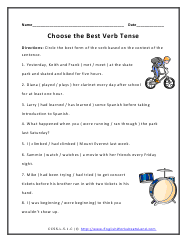

#Choose past tense present professional#
And when a verb ends in a consonant and -y, we change the -y to -i and add -ed.īy learning the simple past you can describe many things about your personal and professional life. There are many irregular verbs but below you can find the most common ones that you need to know for daily use.Īs you can see from these examples, with most regular verbs we add -ed. For irregular verbs, however, the simple past form doesn’t follow this rule and can vary significantly and you simply need to learn them by heart. In order to convert regular verbs from their base form to the simple past form, we add -ed.

To make questions in the simple past we use ‘did’ in front of the subject and base form of the verb.ĭid + subject + base form of verb + object? They didn’t go to the theater last month. Subject + did not + base form of verb + object To make negative negative sentences in the simple past we use the auxiliary ‘did not’ / ‘didn’t’ and the base form of the verb. In affirmative sentences the word order is subject + verb and the form of the verb in the simple past is the same for all subjects (with the exception of ‘to be’ – was/were). I often played football when I was a young man. Time expressions like always, often, usually and never can be used to underline this. It should be clear in this kind of sentence that the action referred to is a habit. These sentences have the same purpose as the expression ‘used to’. The Simple Past can also be used in sentences that describe past habits.In this case, the process of the action is long and is used by specifying time periods such as ‘the whole year’ or ‘all day’. The Simple Past is used to describe a process that started and finished in the past.

I finished work, walked to the beach and met my friends. The Simple Past is used to describe several actions that were completed in the past.It’s also possible to use the simple past in a sentence without specifying a time, but it must have previously been made clear that the speaker is referring to a finished period. The Simple Past is used for actions that started and finished at a specific time in the past.So let’s start learning the Simple Past Tense – one of the most common tenses in spoken English – and the points to pay attention to. The action may have been in the recent past or a long time ago. What matters is that the action was completed in the past. In the Simple Past the process of performing the action is not important. The Past Simple Tense is used to refer to actions that were completed in a time period before the present time.


 0 kommentar(er)
0 kommentar(er)
